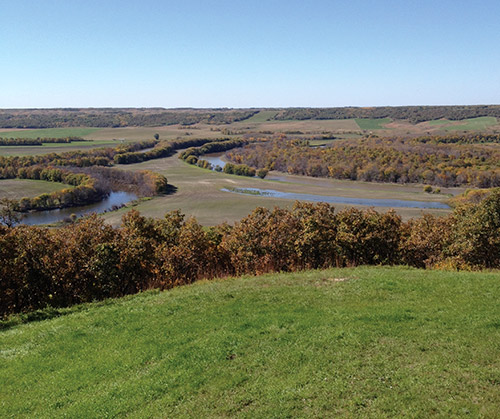Progress Report on the Lake Winnipeg Basin Initiative 2012 to 2013 and 2014 to 2014: chapter 5
Transboundary Partnerships
The Lake Winnipeg Basin covers approximately one million square kilometres encompassing parts of two countries, four provinces and four states. This has resulted in complex governance with respect to transboundary water management in the basin due to the numerous stakeholders, jurisdictions and organizations involved. No one jurisdiction has sole authority to address the issue on its own.

Birdtail Creek near Miniota, Manitoba.
International and provincial water management boards play a key role in establishing transboundary nutrient objectives that are critical for telling us how much phosphorus we can expect the lake to naturally process from each waterway. Governments can then make decisions that will guide actions to meet these nutrient objectives. Environment Canada participates on a number of water science and water management boards (e.g., Prairie Provinces Water Board, International Joint Commission [IJC] boards) to facilitate coordinated and integrated nutrient management efforts across the basin and to help address nutrient loading originating from within and outside of Manitoba’s borders.
The Transboundary Partnerships pillar of the LWBI (formerly known as the Governance pillar in LWBI Phase I) places an increased emphasis on the use of existing transboundary water management boards to encourage government action to reduce nutrients. There is also an increased focus on working more closely with other governments (provincial, state, federal), jurisdictions and organizations within the basin to manage nutrients affecting water quality.
In Phase II of the LWBI, Environment Canada transboundary partnership activities in the basin seek to:
- Engage upstream jurisdictions to effectively manage nutrients;
- Coordinate and complement nutrient management efforts; and
- Ensure that policy, science and program development is informed with information relevant to Lake Winnipeg ecosystem health.
As well, Environment Canada continues to ensure priority progress on nutrient issues through domestic and international water boards is made while working with partners toward the development of a broad binational nutrient management strategy across the basin.
Progress in 2012-2013 and 2013-2014
- Environment Canada and Manitoba Conservation and Water Stewardship continue to implement the Canada-Manitoba MOU Respecting Lake Winnipeg and the Lake Winnipeg Basin (2010) by co-chairing and providing secretariat support to the Canada-Manitoba MOU Implementation Steering Committee. The MOUformalizes the commitment of both governments to a long-term, collaborative and coordinated approach to support the sustainability and health of the lake and its basin. The MOU Steering Committee met three times in the 2012-2013 to 2013-2014 period and shared information amongst federal and provincial departments on programs and issues affecting the health of Lake Winnipeg. The MOU Secretariat initiated a management review of the Canada-Manitoba MOU to inform decisions related to the extension of the MOU after its expiration in September 2015.
- Environment Canada is an active member of the IJC’s Water Quality Committee of the International Red River Board. The Water Quality Committee is tasked with implementing the Basin-wide Nutrient Management Strategy for the International Red River Watershed. This IJC committee is currently focusing on developing nutrient load allocations and/or water quality targets for nutrients for the Red River. A literature review on methods for setting nutrient objectives in the Red River portion of the Lake Winnipeg basin was completed and accepted by the International Red River Board. The committee is moving forward with the recommendations from the review to develop a model of the relationships between nutrient concentrations in the river and criteria to protect or restore water resource uses (aquatic life, recreational use, etc.).
- In December 2012, the Canadian Consulate in Minneapolis invited Environment Canada to participate in a panel discussion at a forum it was hosting on water quality in Lake Winnipeg and the Red River Basin. This provided an opportunity to inform a broader international audience of Environment Canada actions to address Lake Winnipeg’s water quality problems.
- Environment Canada provided support to Manitoba Conservation and Water Stewardship and the South Basin Mayors and Reeves on the formation and implementation of the provincially led Lake Friendly Accord and Stewards Alliance. The Lake Friendly Accord document is a declaration of support by signatories to take action to reduce nutrient loading and improve water quality in the Lake Winnipeg basin. The federal Minister of the Environment signed the accord on behalf of the Government of Canada on March 21, 2014, and was one of the first signatories of the accord. Environment Canada staff participated in the Lake Friendly Stewards Alliance Steering Committee, assisting in developing an overall vision, overseeing the implementation of the accord, and participating in working groups related to Governance, and Science and Research.
- Environment Canada increased its engagement with United States jurisdictions to address nutrient issues within the U.S. portion of the Lake Winnipeg basin. Staff attended North Dakota’s Nutrient Reduction Strategy Stakeholder meeting and participated in follow-up working groups. Environment Canada staff also attended the 2013 Minnesota Water Resource Conference, where the Pollution Control Agency presented Minnesota’s Nutrient Reduction Strategy and announced the launch of its consultative process on the strategy.